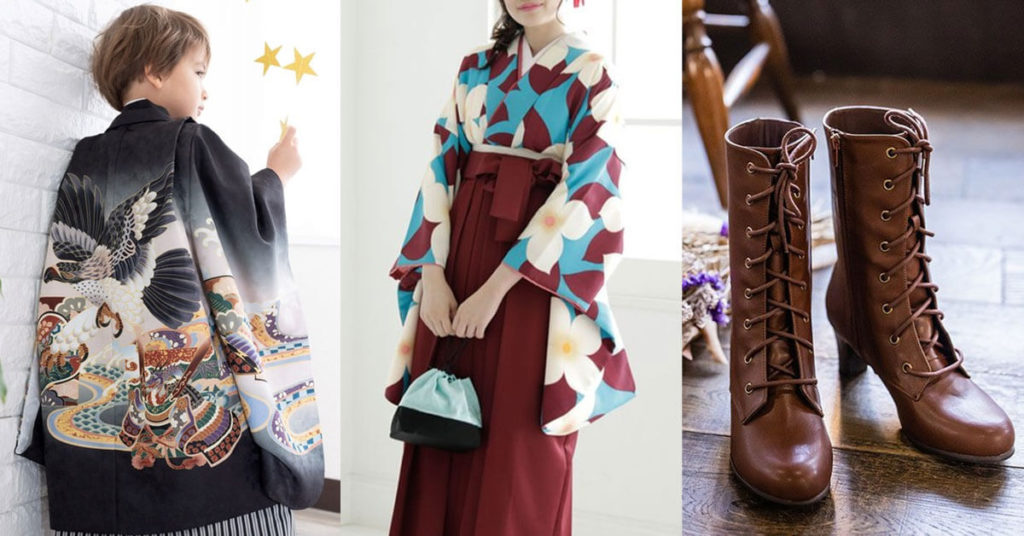
Japan has its own traditional fashion, such as kimonos and yukata, which reflect the country’s rich history. Imagine a samurai or a ninja, dressed very differently from the Japanese of today. The kimono, which was common in Japan before the Meiji period, is now considered a formal outfit for important events as part of traditional culture.
Hakama is an indispensable formal wear worn over a kimono. In this article, we will focus on hakama.
What are Hakama?
Hakamas are thick trouser-like garments and are traditional Japanese ones. Hakama is believed to have taken its form in Japan as early as BC. In ancient history, hakama were an everyday pant-like garment, but from the Heian period to the Edo period, they were a special garment that only high status aristocrats were allowed to wear. After the Meiji period, hakama were no longer worn on a daily basis. However, men still wear hakama as formal attire at weddings, New Year’s day, coming-of-age ceremonies, and other traditional Japanese events. For women, the culture of wearing hakama for college graduation ceremonies remains, as the fashion of female students wearing hakama became a trend during the Meiji era. In addition, formal wear of hakama under a white kimono is common for Shinto priestesses, called miko, at shrines and temples, where only women are allowed to become priestesses. As you can see, although hakama are not worn in daily life in Japan today, the culture of wearing kimono still remains as a traditional culture cherished by the Japanese people.
Meaning and history
Traditional Japanese clothing strongly reflects the background of Japanese history. Before the Meiji period , when Japan still had a class system such as samurais, farmers, artisans, and merchants, hakama were worn as formal wear by people of high rank, such as samurai families. In the old days, there was still a culture of male chauvinism, and women in particular were only allowed to wear hakama if they were of high status and lived in the court. Before the Meiji era, hakama was a symbol of high status. However, after 1868, when the status system was abolished, hakama were worn by men, women, and people of any status. It became common for women to wear hakama as well, and rich female students with access to higher education would prefer to wear them. This fashion style became a trend as it symbolized the glamorous life of a student, and the hakama style mimicking that of female students became a fashion trend. This led to a connection between academics and hakama, and today, the culture of wearing hakama as formal outfit for college graduation ceremonies remains in modern Japan. Hakama rental businesses for college graduation ceremonies exist in Japan, and it is common for college students to select their favorite hakama more than a year in advance.
Womens Hakama
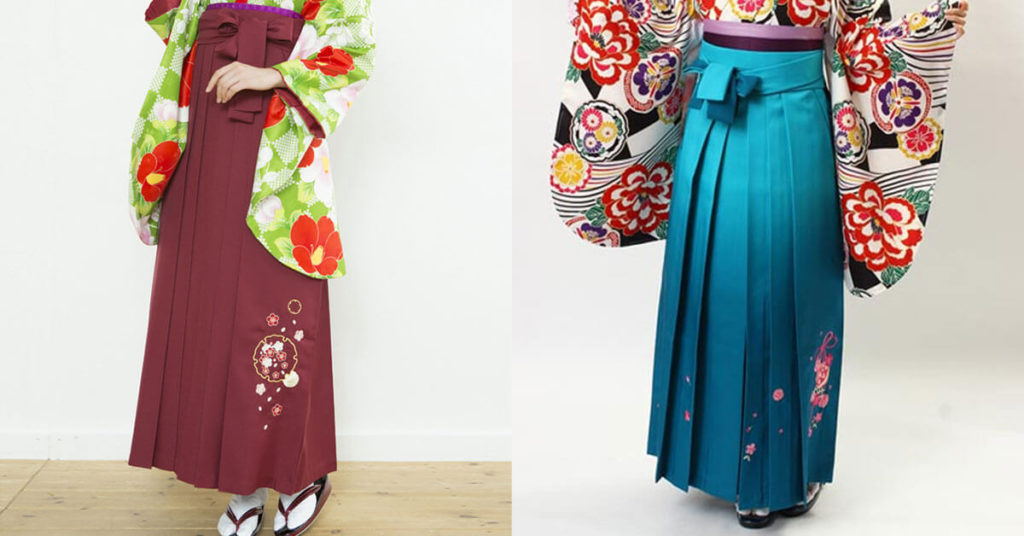
Originally, hakama were worn as men’s formal wear, but when women began wearing hakama as well, a genre of hakama for women called onna-bakama was created. Unlike men’s hakama, women’s hakama are skirt-like and have no partition between the legs like pants. They are often pleated and do not have a waistband like men’s hakama, making them easier to wear. Also, the obi is tied under the chest instead of the waist, making it comfortable and pain-free to wear. The hakama is a large piece from the chest down, so while the kimono is worn over the hakama is important, thus choosing a hakama that fits you is the key to fashion.
Mens Hakama
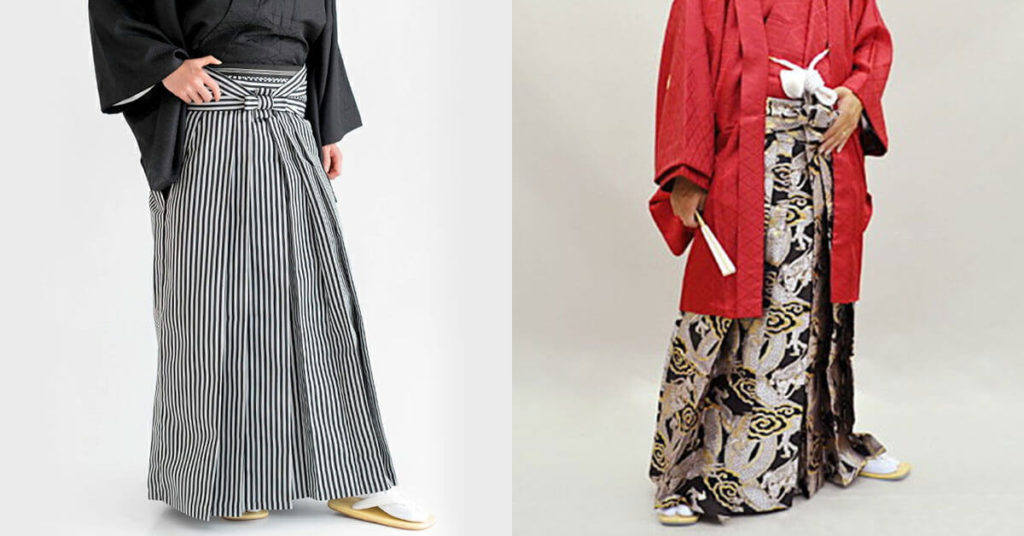
There are two main types of hakama for men. Since it was worn by warriors as formal wear for going to battles, hakamas are categorized in two types: the “uma-nori-hakama,” which is shaped like today’s trousers so that it can be worn over a horse, and the “andon-hakama,” which is skirt-like similar to a woman’s hakama. The horse-riding hakama is more common and is worn more often. However, some people choose the adon hakama for reasons such as allowing easy access to the restroom. The material of the hakama determines the degree of formality. Thin and lightweight fabrics are used for everyday wear and fashion, while heavier and heavier fabrics are used for formal occasions such as festivals and weddings. The degree of formality is also depicted on the pattern. Hakama with a striped pattern are considered the most formal, followed by plain, and then patterns other than striped, in that order. It is important to choose according to the event you will attend and the place you will wear it.
Hakama in martial arts
Hakama are also incorporated into traditional Japanese martial arts pants. Karate, kendo, and other traditional Japanese martial arts include a variety of genres.
Aikido
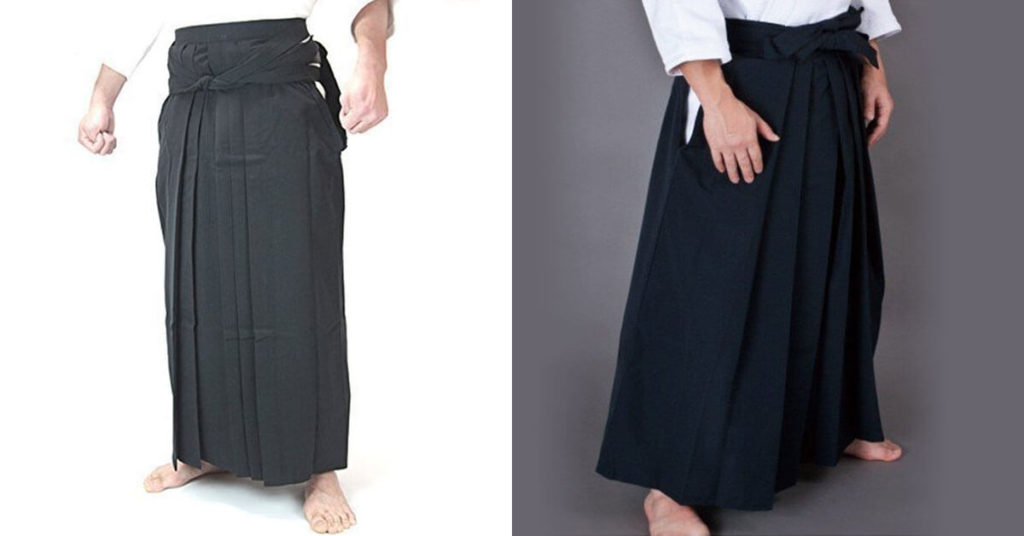
Aikido is one of Japan’s representative martial arts, along with karate, judo, and kendo. After the Pacific War, it spread not only in Japan but also throughout the world. Aikido is a martial art that trains not only the body but also the spirit, and by harmonizing with nature, it is the art of conquering opponents regardless of their size. In Aikido, the formal attire is a white robe and black or navy blue hakama. Aikido has five folds in the front and one in the back, based on the Yin-Yang Five Elements Theory, which states that odd numbers are good numbers. Hakama are narrower than other Japanese martial arts and are worn with a tighter waist strap than other Japanese martial arts. The most popular brands for aikido hakama are Iwata, which has been in business for more than 100 years, and the long-established Kyoto-based brand, Tozando, which offers many other traditional Japanese martial arts clothing options in addition to aikido hakama.
Kendo
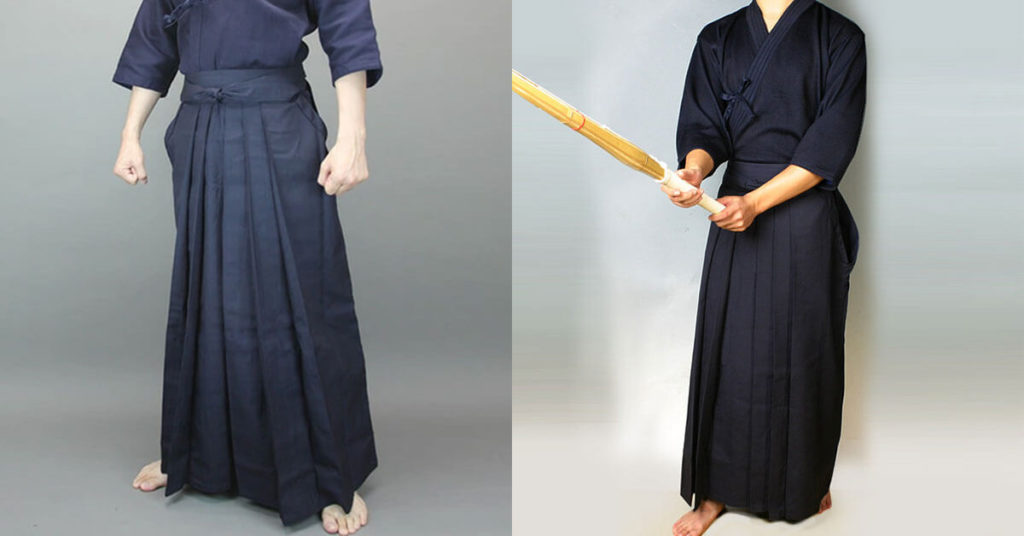
Kendo is a Japanese martial art that uses a sword made of bamboo, called shinai. In Japanese martial arts, it is important to train the body and master the techniques, but it is equally important to have a good mental attitude. Kendo is also a sport that requires spiritual mastery, and the hakama worn in kendo also has a meaning. Kendo has five folds in the front and two at the back. The five folds on the front side represent the five virtues that man should always observe. The five virtues are as follows benevolence: a mind that conquers itself and is considerate of others justice: observes right conduct courtesy: respect for courtesy and civility wisdom: knowing the reason for things and making the right decision sincerity: faithful and true heart without spot In kendo, this teaching is always important. In addition, the two folds at the back signifies these two important Confucian teachings. loyalty: the sincerity to serve the lord filial piety:the heart to care for parents and siblings Although there is a wide range of theories, the hakama worn in kendo represents these.
Iaido
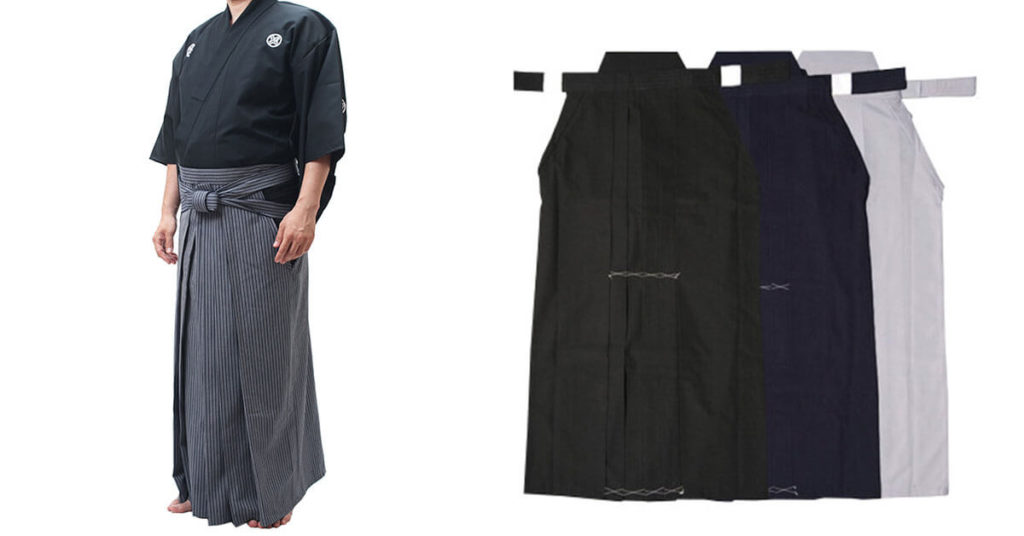
Iaido is a competition of swordsmanship skills by schools of swordsmanship. It is said to have existed since the Edo period (1603-1867), but it still exists as one of the Japanese martial arts after the samurai class was abolished in the Meiji period and the carrying of swords was prohibited by law, called the Abolition of Sword Law. Generally, fake swords are used, but advanced practitioners use real swords called Shinken. It is common to hold consultations wearing a dogi and hakama, and advanced students wear the most prestigious material as formal attire or a striped hakama.
Kyudo
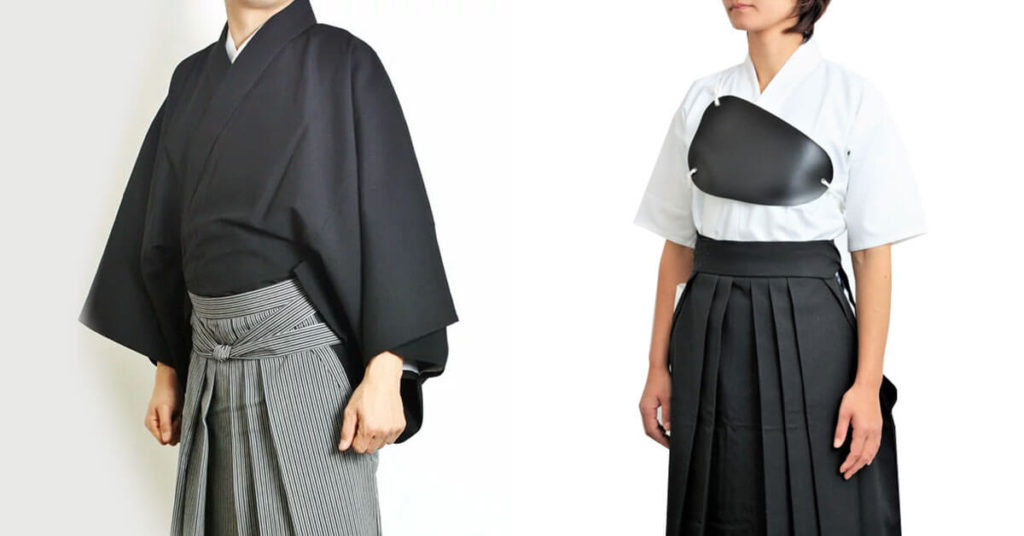
Kyudo is a sport using bows and arrows, and competitors wear a Japanese archery uniform. When wearing a Japanese archery uniform, you must wear the following:
- Jacket
- Hakama
- Obi (sash)
- Tabi (socks).
Both men and women generally wear the bajo hakama, which was worn by warriors astride horses during the Sengoku period.
Outside of sports
Hakama are still worn today in various traditional Japanese events outside of sports.
Graduation
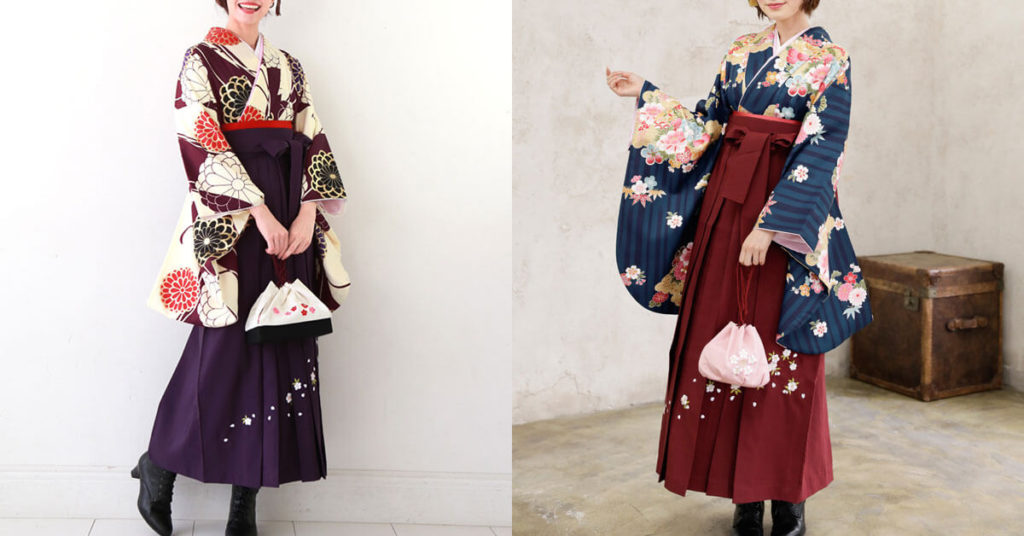
In Japan, junior high and high school students wear uniforms for graduation ceremonies while hakama are worn mainly for college graduation ceremonies. It has become so common that hakama is the most commonly worn uniform for graduation ceremonies, regardless of gender. Since few families have their own hakama, it is now common for students to rent them.
Wedding
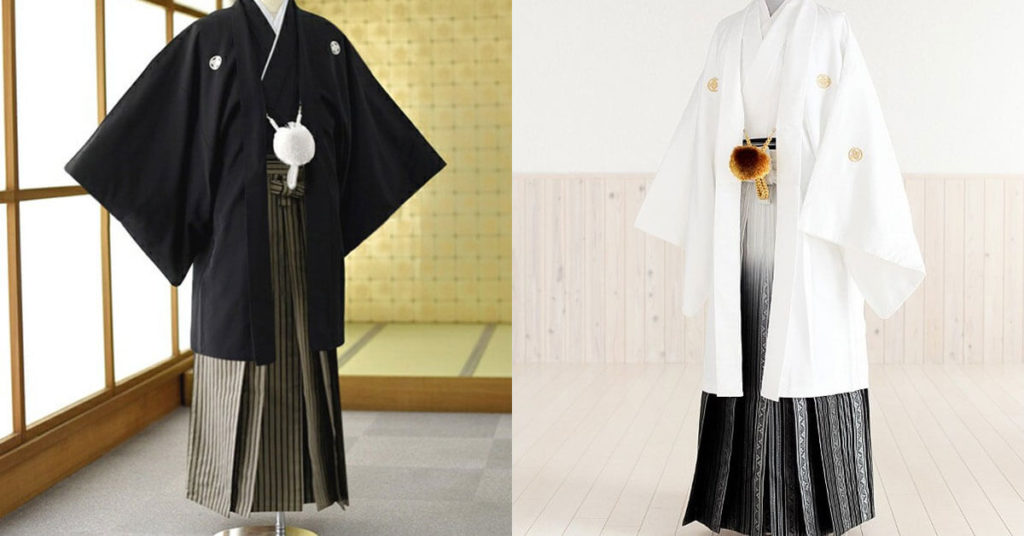
In Japan, Western-style church weddings have become more common in recent years, but some couples choose to have a traditional wedding at a shrine or temple. Even in a western wedding theme, kimonos are still often used, with the men wearing hakama as formal wedding attire. There are certain formalities for kimono depending on the way the kimono is folded, the material used, and the pattern. It is important for the bride and groom to be consistent in the prestige level of their kimono while the men’s hakama are chosen accordingly.
Hakama Fashion
Few Japanese people today know how to properly dress in kimono, including hakama, but in order to wear hakama fashionably, it is necessary to have a variety of knowledge about kimono depending on the items to match.
With Kimono
Kimonos and hakama are often confused, but they are different. Hakama are usually worn over a kimono. Matching colors and patterns is important, but the most crucial thing in Japanese dress is to match the style of the kimono to the place where it will be worn. Most women’s hakama are plain and pleated, so the kimono pattern can be used to add individuality. Once you have matched the hakama and kimono styles, you can then choose a kimono pattern that you like. Yukata, which is considered a summer kimono, is a casual kimono and cannot be worn with hakama.
Hakama and Haori
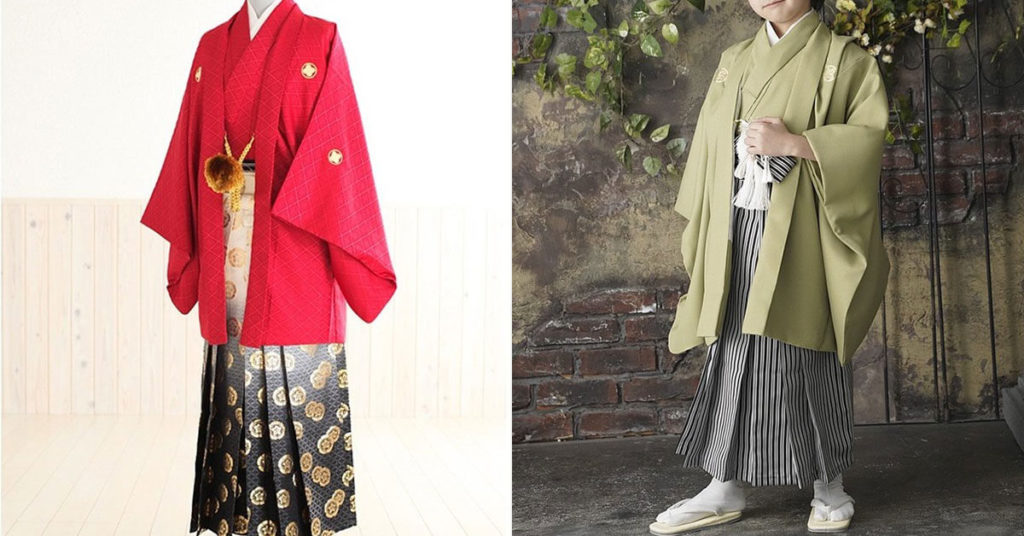
Since haori is often worn in formal occasions, hakama are naturally chosen to be more formal as well. When worn by men at weddings, the most common haori hakama is the black haori hakama with five black crests or the royal groom’s kimono. The black crested haori and the prestigious striped hakama give a very firm and solid impression.
Boots and Accessories
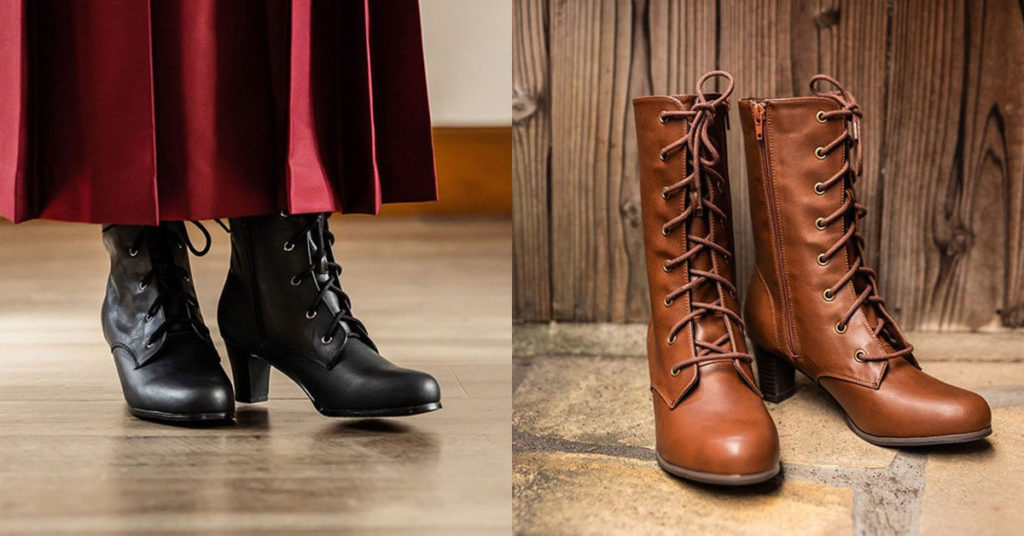
In addition to zori, boots are sometimes worn with hakama. Hakama, a traditional Japanese dress, and boots, a western footwear, may seem like a mismatch, but female students in the Meiji era combined hakama with boots, and even today some people incorporate boots into their fashion. For women, it is recommended that when wearing zori sandals, their hakama should be long so that tabi socks will not be visible, and when wearing boots, their hakama should be short as well so that the hems will not be stepped on. For accessories, too, if you are looking for the perfect kimono, you should choose Japanese-style accessories such as kanzashi (hairpin) and obijime ornaments, but nowadays it is becoming more conventional to wear common accessories, so it is recommended to incorporate what you think is pleasant to your outfit.
Tying a Hakama
Wearing a hakama is not an immediate task as you will have to learn how to wear it on. Here is a brief introduction on how to put on the Hakama.
Folding a Hakama
The hakama is worn over the kimono after it is put on. The front side of the hakama has several folds, which are aligned to the middle of the body and pinned to the kimono obi 1-2 cm out. The front hakama strap is wrapped around the kimono obi once around the waist and then tied under the kimono obi’s wings. The back hakama is then placed on top of the kimono obi and brought to the front and tied to secure. There are various ways to tie the knot, but the most common is to tie it in a ribbon knot slightly next to the waist. The hakama itself is not too difficult to put on, so go try it on yourself.
Buying a Japanese Hakama online
Japanese online stores offer a wide variety of kimonos. Since new kimonos are relatively expensive, we recommend that you buy something affordable from an online store to experience Japanese-style clothing. Hakama are still used today for events such as coming-of-age ceremonies, and there is a wide variety to choose from. If you are interested, please check out our online store.

